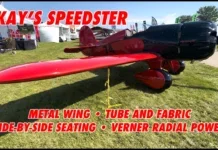 The Rand-Robinson KR series turns 50 in 2022 and to celebrate KITPLANES has met up with a couple of KR builders and owners to see what makes these lithe, efficient homebuilts tick. Here’s the story from Chris Pryce about his KR-2S “ish” with Corvair power and many modifications.
The Rand-Robinson KR series turns 50 in 2022 and to celebrate KITPLANES has met up with a couple of KR builders and owners to see what makes these lithe, efficient homebuilts tick. Here’s the story from Chris Pryce about his KR-2S “ish” with Corvair power and many modifications.
Chris Pryce, perhaps typically of many KR builders, describes his airplane as a “KR-2 ish,” in part because it’s actually a fair distance from the original idea of the KR-2. “It represents one of the newest versions of the KR-2S line. It’s even longer than the S,” he says. Where most of the stretched KRs have a 14-inch plug behind the wing, Pryce’s has a 28-inch fuselage stretch that he says is aimed at remedying “the stability issues” of the original design. (Before the KR faithful rise up and call heresy, understand that Pryce’s day job is inside a KC-10 tanker, where stability isn’t just a good thing, it’s essential.) He also altered the taper of the fuselage, which normally starts near the wing leading edge. His KR is straight until the seat bulkhead and then begins tapering to the tail, all in service of more cabin space.
He’s made other changes to the fuselage. “I’ve made it wider and taller because I’m wider and taller,” says Pryce. “I’m using a Dragonfly canopy and the fuselage is 42 inches wide at the shoulders, compared to 32 inches for the plans.” (The KR-2 was somewhat notorious for being compact, as was Ken Rand himself.) “This is the more modern-day KR built for modern-day-sized Americans,” the 6-foot-3 Pryce says. He’s set the maximum gross weight to 1300 pounds against an empty weight of 750 pounds.
In addition to the stretch, Pryce’s KR has a new horizontal tail. “It’s an open-source design from the KRnet, with symmetrical airfoils and more stabilizer area.” His KR also sports a taller rudder than the design originally had and he’s using “an open-source laminar airfoil [on the main wing] for ‘free’ speed.”
Another avenue to performance is power. “I have a lot bigger motor. I have a 120-hp Chevy Corvair 3-liter on it.” To feed the Corvair, Pryce built wing tanks. “I have 16 gallons a side for 32 gallons of gas, but I only burn 5–6 gph in cruise, so the KR can fly longer than I can, which is great. It’s a really good utility airplane for cross-countries on a budget,” he says.
“For cross-country flying, I plan on 170 mph on 5–6 gph (with the wheel pants on). Stall speed is 62 mph indicated but that’s really about 57 mph since my system reads about 5 mph fast. But it’s a very docile stall. Kind of like a Cessna.” Climb rate at max gross is 500–600 fpm, but at lighter weights and less than full fuel, he sees 1300 fpm.
Pryce’s story has a family connection. “For me, the KR has a lot of sentimental value,” he says. “The wood kit from this airplane was my father’s from the year I was born,” he says, noting that his father never got to build it. “I grew up with a fuselage of a KR in the garage. So as a kid I always knew I wanted to build one. And when the time came I told my father that, and he sent me what he had. Yes, I built this myself, but this is a very sentimental airplane for my father and me.” His father very much enjoys flying with him—“we flew to Oshkosh to debut this airplane [in 2021] and we’re doing it again this year for the 50th anniversary.”
His father also appreciates the personalization. “That’s the beauty of the KR,” Pryce says. “There are no two the same. I didn’t do anything on this airplane that I didn’t know had been flight tested, yet it was built to fit me.”
Pryce’s workmanship is exceptional. Even though he “painted it in my garage,” it doesn’t look it. His clever ideas, such as a forward deck that removes in seconds after pulling the single piano hinge pin for the canopy, are aimed at making a KR not only his personal expression, but a safer, more easily maintained airplane.














Wonderful, beautiful Airplane